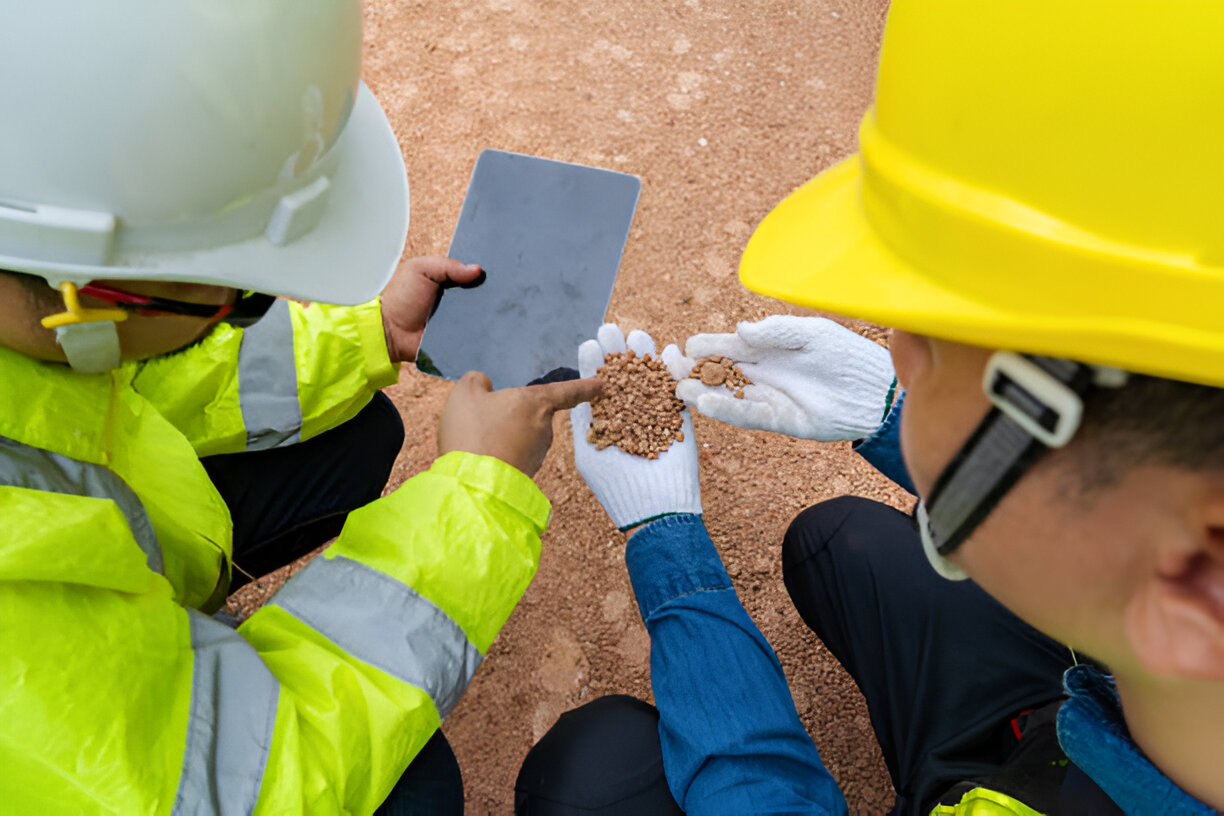
Site Preparation Checklist: Soil Testing, Sand Selection & More
1. Pre-Construction Survey and Site Clearance
The first and foremost step before any construction activity begins is a thorough site survey and clearance. This phase involves:
- Identifying Site Boundaries: Using tools like total stations and GPS equipment to accurately mark land boundaries.
- Checking for Encroachments: Ensuring that no unauthorized structures or occupations exist on the plot.
- Locating Utility Lines: Surveying for underground and overhead utility lines such as electricity, water, gas, or sewage lines.
- Clearing Vegetation and Debris: Removing shrubs, trees, old foundations, or waste that may hinder excavation and construction.
- Legal and Zoning Compliance: Verifying land ownership documents, obtaining building permits, and confirming zoning permissions.
This stage sets the tone for an organized construction process and helps avoid legal and structural complications later.
2. Soil Testing: Foundation Begins Here
Soil testing is a critical component of site preparation. The ground beneath your building determines how strong and long-lasting the structure will be. Geotechnical soil testing includes:
- Soil Classification: Identifying whether the soil is clay, loam, sandy, silty, or a mix.
- Load-Bearing Capacity: Determining how much load the soil can safely support, which guides the type and depth of foundation.
- Moisture Content & Groundwater Level: Evaluating the water table to prevent water seepage into basements or foundations.
- Soil pH and Chemical Composition: Analyzing for chemicals or salts that might corrode steel or concrete.
Testing should be conducted by a certified geotechnical laboratory. The report typically informs the structural engineer on whether to go for a shallow or deep foundation (e.g., pile, raft, mat).
3. Land Grading and Site Leveling
Grading and leveling are essential for both safety and precision:
- Site Grading: Adjusting the slope of the land to ensure water runoff flows away from the foundation and avoids pooling.
- Land Leveling: Creating an even surface for laying out the foundation and structural elements.
- Drainage Slopes: Incorporating slight gradients to promote proper drainage and minimize erosion.
- Earthmoving Equipment: Using bulldozers, graders, and excavators to reshape and level the land.
Proper grading ensures that during heavy rains, water doesn’t collect near the structure, preventing structural damage over time.
4. Sand Selection: Why Type and Quality Matter
Sand is a fundamental construction material, but not all sand types are suitable for every building project. Here’s a breakdown:
- River Sand: Naturally occurring, fine-grain sand with good binding quality. Ideal for plastering and concrete work.
- M-Sand (Manufactured Sand): Produced by crushing rocks. M-sand is angular and has better compressive strength, making it suitable for concrete.
- Pit Sand: Coarse and red-orange in color. Mostly used for mortar.
Key Quality Checks for Sand:
- Low silt content (ideally under 8%)
- Uniform grain size
- Free from organic impurities
- No excessive clay or debris
Due to increasing restrictions on river sand mining, M-sand has emerged as a sustainable and cost-effective alternative.
5. Compaction and Soil Stabilization
Loose or weak soil must be treated before foundation work. Here’s how:
- Compaction: Compressing soil particles to increase density. Methods include:
- Plate compactors for small areas
- Vibratory rollers for large sites
- Rammers for confined spots
- Soil Stabilization: Enhancing soil strength with additives:
- Lime Stabilization: Reduces plasticity and swelling in clayey soils.
- Cement Stabilization: Improves load-bearing for roads and buildings.
- Geotextiles or Geo-grids: Synthetic fabrics that reinforce weak soils.
These measures prevent differential settlement, cracking, and foundation failure.
6. Site Drainage Planning and Implementation
Efficient drainage is non-negotiable. Poor drainage leads to waterlogging, structural damage, and even health hazards. Here’s what to plan:
- Temporary Drainage: Trenches and sumps during construction to redirect rainwater.
- Permanent Drainage:
- French Drains: Gravel-filled trenches with perforated pipes
- Stormwater Drains: Channels to carry water away from the building
- Catch Basins: Trap debris while draining water
Also, ensure downspouts and roof drainage are directed away from the foundation to protect substructures.
7. Temporary Site Infrastructure: Access Roads, Storage & Utilities
For uninterrupted workflow and safety, temporary infrastructure must be set up:
- Access Roads: Gravel or compacted dirt roads for trucks, cranes, and workers.
- Material Storage: Designated areas with waterproof covers for cement, steel, bricks, and aggregates.
- Worker Facilities:
- Toilets and drinking water
- Rest areas and shade zones
- Utility Setup:
- Temporary electricity poles or generators
- Water supply through tankers or borewells
A well-laid-out site infrastructure reduces delays, improves safety, and enhances overall productivity.
8. Safety Precautions and Signage Setup
Construction sites pose multiple safety risks. Mitigate them by:
- Perimeter Fencing: To prevent unauthorized access
- Barricades & Warning Signs: Around excavation zones, hazardous equipment, or unstable surfaces
- PPE Zones: Designated areas where helmets, boots, gloves, and vests are mandatory
- Emergency Protocols:
- First-aid kits on-site
- Fire extinguishers
- Trained safety supervisors
Follow the norms set by local building codes and labor safety regulations to avoid legal issues.
9. Environmental and Legal Compliance
Every construction site must comply with environmental and legal norms:
- Dust & Noise Control: Use water sprays, green netting, and sound barriers.
- Waste Disposal: Separate and properly dispose of construction waste, hazardous material, and general garbage.
- Tree Protection: If trees are to be retained, protect root zones using fencing.
- Regulatory Approvals:
- Building Plan Approval
- Environmental Clearance (if applicable)
- NOC from Fire Department
- Consent from Pollution Control Board
Non-compliance can lead to stop-work notices, fines, or project delays.
10. Final Inspection Before Construction Commences
Before laying the foundation, carry out a comprehensive inspection:
- Soil Test Report Verification: Ensure it aligns with structural recommendations.
- Sand and Material Quality: Cross-check supplier certifications and on-site conditions.
- Survey Markings: Layout lines for foundation and walls must match architectural drawings.
- Documentation Review:
- Approvals and permits
- Site plan and structural drawings
- Contracts and vendor agreements
This final step ensures the site is 100% ready for a seamless transition into the foundation and building phase.
Conclusion
A well-prepared site lays the groundwork for a successful construction project. From the granular details of soil testing to the logistical aspects of access roads and legal compliance, each task is critical. Overlooking any part of this checklist can result in delays, budget overruns, or long-term structural issues.
Whether you’re an individual building your dream home or a contractor managing multiple projects, investing time in thorough site preparation will pay off in quality, safety, and efficiency. Looking for a printable version of this checklist or customized consultation? Feel free to reach out—we’re here to help!



